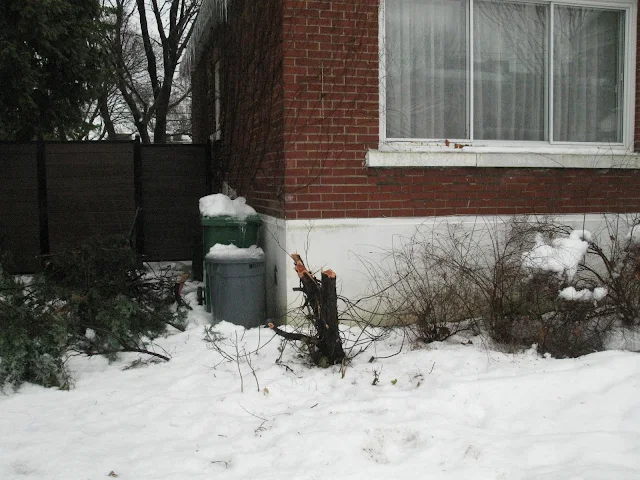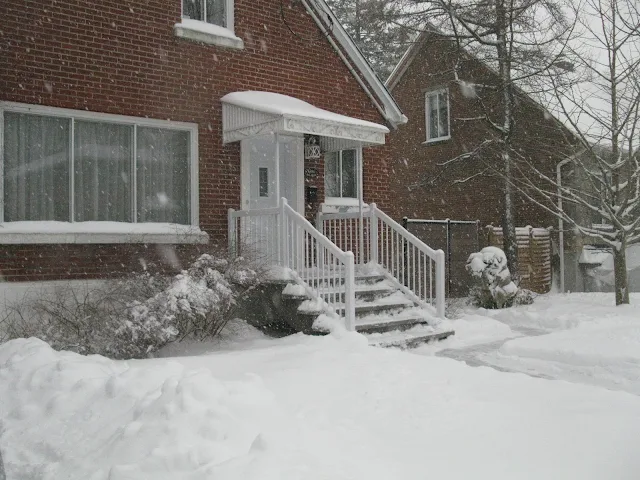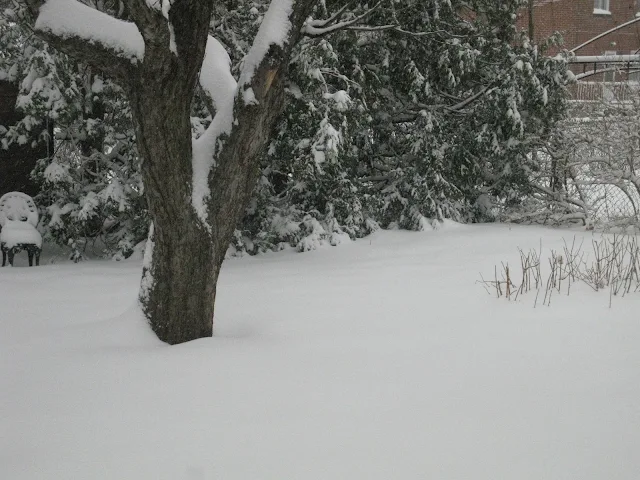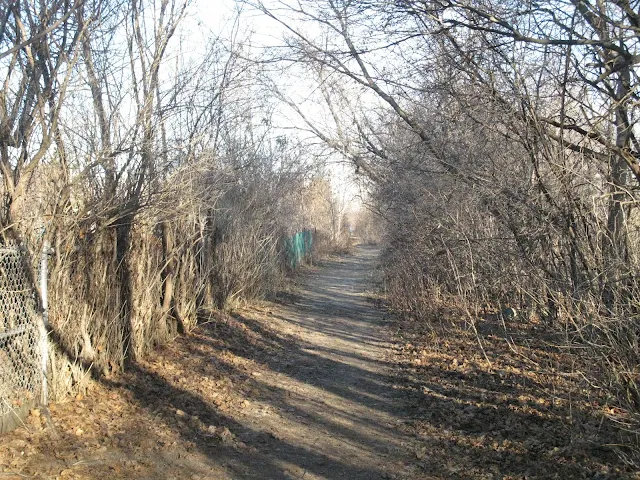Here are the empty shelves at a local pharmacy, part of a country-wide chain of pharmacies. It's been like this for months, no Tylenol and other medication for children at a time when many children are getting the flu and other illnesses that require reducing fever. Who would have ever thought that Canada in 2023 can't even have basic medication for children? That's the result of seven years of Justin Trudeau's government.
Monday, January 16, 2023
Saturday, January 14, 2023
Yesterday's snow storm
Friday, January 13, 2023
"The Trees are Down" by Charlotte Mew
Wednesday, January 11, 2023
"Stars" by Emily Bronte
Ah! why, because the dazzling sun
Restored our Earth to joy,
Have you departed, every one,
And left a desert sky?
All through the night, your glorious eyes
Were gazing down in mine,
And, with a full heart’s thankful sighs,
I blessed that watch divine.
I was at peace, and drank your beams
As they were life to me;
And reveled in my changeful dreams,
Like petrel on the sea.
Thought followed thought, star followed star,
Through boundless regions, on;
While one sweet influence, near and far,
Thrilled through, and proved us one!
Why did the morning dawn to break
So great, so pure, a spell;
And scorch with fire the tranquil cheek,
Where your cool radiance fell?
Blood-red, he rose, and, arrow-straight,
His fierce beams struck my brow;
The soul of nature sprang, elate,
But mine sank sad and low!
My lids closed down, yet through their veil
I saw him, blazing, still,
And steep in gold the misty dale,
And flash upon the hill.
I turned me to the pillow, then,
To call back night, and see
Your worlds of solemn light, again,
Throb with my heart, and me!
It would not do—the pillow glowed,
And glowed both roof and floor;
And birds sang loudly in the wood,
And fresh winds shook the door;
The curtains waved, the wakened flies
Were murmuring round my room,
Imprisoned there, till I should rise,
And give them leave to roam.
Oh, stars, and dreams, and gentle night;
Oh, night and stars, return!
And hide me from the hostile light
That does not warm, but burn;
That drains the blood of suffering men;
Drinks tears, instead of dew;
Let me sleep through his blinding reign,
And only wake with you!
Sunday, January 8, 2023
“Bright star, would I were stedfast as thou art” by John Keats
Friday, January 6, 2023
Hortus Conclusus at Le Grand Seminaire
Years ago, I visited Le Grand Seminaire, it is where my great great uncles, Fr. Martin Callaghan and his brother Fr. James Callaghan are buried. It is also where both men were educated in the late 1800s and I've always felt that attending this school was a great opportunity for both men; they were born into the working class, they became priests, educated men, and they served their community. A few years after this first visit I went on a tour of the seminary; it is located on Sherbrooke Street West near Atwater. From the street you can see the twin towers, built in the late 1600s, they were a place of safety when Indigenous people might attack the compound; it was where they would hide in the towers.
 |
| Note the image of Christ at the top left of this image; this hortus conclusus corresponds better to the garden at Le Petite Seminaire in Old Montreal |
On my first visit to Le Grand Seminaire I walked around the grounds; there is a kind of enclosed garden or green space; you can see the stone walls that surround the place below. There is a rectangular pool, see below, that had been neglected. I suspect that access to the grounds is now more difficult as the old seminary has become quite a prestigious private high school.
.jpg) |
Le Grand Seminaire from Sherbrooke Street West.jpg) .jpg) These twin towers can be seen from Sherbrooke Street West  |
 |
| Drawing of Le Grand Seminaire from 1600s |
Wednesday, January 4, 2023
Deletions from an Introduction for a Selected Poems (3)
In
1975 I published "The Insecurity of Art", an essay describing that
poets need to begin from a place of not knowing, of insecurity, and this becomes a place of discovery. I write out of what I have experienced and sometimes this is also a place of darkness, we've all experienced darkness at some time in our lives: some are lost in a dark forest; others have
descended to the underworld; and some of us had to begin life again in middle
age, for nothing was as we believed. But darkness is also a place of creativity, of self-awareness, of rebirth and vision. And so I ask, what can be seen in the immensity of this darkness no
matter how dark it is? It took me many years to know what is obvious to others; that tiny dot of light in the darkness is the
discovery of love in one's life. It is greater than any darkness.
Monday, January 2, 2023
Farewell, Tree
We've just had some of the big snow storm that crippled parts of Canada and the United States; some people here lost electricity due to the strong winds but, overall, Montreal was spared the very worst of the storm. But what wasn't spared was a tree we had at the front of the house; it was never much of a tree and for years I had a wire connected from the tree to the wall of the house, to hold it just in case it fell over.
Now the tree is gone. We planted the tree at least twenty years ago; farewell twenty years of growing, Tree; farewell to 20 to 25 feet in height, Tree. The tree didn't collapse, it broke under the weight of the snow. Then I had the job of cutting it up; which, against my self-doubts, I did.
I was of two minds regarding losing the tree. I wanted the tree but not necessarily this tree . . . although better this tree than no tree at all which is what I now have. It was never a great tree, it was a good enough tree; it tended to thinning out, but a few years ago I topped the tree and forced the growth to the bottom branches and the whole tree filled out nicely. That improved the tree. A tree, even this tree, adds a lot to the landscaping of a house, remove the tree and you are no longer distracted from the house that needs painting, pointing, and general maintenance. And I am basically a tree lover and don't like to cut down any tree. Farewell, Tree . . .
I wasn't sure I was up to cutting up the tree; I'm not young, but I did it. And then, a few days after the tree collapsed, I noticed from a basement window chick-a-dees walking around under the cut branches of the tree, finding something to eat. They missed the tree. And later, outside, I saw chick-a-dees sitting on the cut branches, I felt like a traitor to the birds, but I wasn't, I didn't cause the tree to break, all I did was cut up the branches. But the chick-a-dees missed the tree. And then I remembered that I used to sit in our living room, just a few feet from where the tree had been outside, and I could hear chick-a-dees in the tree, they'd sit on the branches, they used the tree, they liked the tree, they were happy in the tree, and here I was cutting up the branches. So, now, the tree has to be replaced with another tree.
 |
| Farewell, Tree |
 |
| Farewell, Tree |
 |
| That's the tree, on the left, in October |
 |
| That's the tree, on the right |
And now I miss the tree.
Sunday, January 1, 2023
"These" by William Carlos Williams
 |
| January 2015 |
are the desolate, dark weeks The year plunges into night to an empty, windswept place that spins a dark fire – to make a man aware of nothing would be embraced – emptiness, the flashes and booms of war; the people gone that we loved, Hide it away somewhere ears and eyes – for itself. music? The source of poetry that that ticked yesterday so well? |
Saturday, December 31, 2022
Wednesday, December 28, 2022
Last walk on the hidden trail for this year
Although we've had a few mild days, the cold is upon us and it makes life a lot less enjoyable. While I am usually happy to go for a morning walk, now, hearing that it is -10 C outside, I think it might be a good day to stay indoors, or go for a shorter walk and buy a few groceries on the way home. There is really nothing appealing about cold weather, not our cold weather. And it was cold a few days ago when I went for a last walk for this year on the hidden trail. The usual conviviality of walkers and dog owners was gone, it was all women dog walkers and me. The dogs enjoyed barking at me, and what of the women? I ignored them as I hurried along, cold, colder, and getting colder still.
Note: these photos were taken at least two weeks ago, before we had all of the snow we now have, and it's still falling.
Saturday, December 24, 2022
The man who saved St. Mary's Hospital
When I was growing up I often heard about the three Callaghan priests, Frs. Martin, James, and Luke. The oldest priest was known familiarly as Fr. Martin, he was the first Montreal-born pastor at St. Patrick's Basilica; when he died he was buried in a plain wooden casket and, as his funeral cortege moved through the streets, people bowed their heads and acknowledged that he was an exceptional and humble man of God; they all loved Fr. Martin. Fr. James, the second born, was less known; the youngest, Fr. Luke Callaghan, was prominent but not as beloved as Fr. Martin.
The Callaghans were proud of all of their children. John Callaghan, their father, was involved in religious organizations in Montreal and, coincidentally, he was a longtime friend of my great great grandfather, Laurence Morrissey, a relationship that predates the marriage of his daughter to Laurence's son, Thomas. The Sulpician order educated these three young men and they each became prominent figures in the Montreal community. Born into the working class their intelligence was recognized by the Church and they were given every opportunity to make something of themselves; they were given the greatest gift, an education.
There is a saying, that one pays something forward (defined as "when someone does something for you, instead of paying that person back directly, you pass it on to another person instead.") Back in the 1920s and 1930s, and before, some members of the Irish Catholic community in Montreal wanted to build a hospital, and they did, it is St. Mary's Hospital which is also a McGill University teaching hospital. It was Fr. Luke Callaghan who saved the hospital when it was in jeopardy of being cancelled; he paid forward the good fortune that he had received from others.
 |
| Father Luke Callaghan |
..jpg) |
| A Notman photograph of St. Michael's Church, 1934; Fr. Luke Callaghan was the pastor here and he helped build the church. |
The mission of founding a hospital originated with Sister Helen Morrissey (no relation) in 1908; she was born in the United States, and she was joined in this work of founding a hospital by Dr. Donald Hingston, an eminent Montreal surgeon and a member of an eminent Montreal family, his father had been a surgeon and mayor of Montreal. The first location of St. Mary's Hospital, chosen by Mother Morrissey, was Shaugnessy House, on then Dorchester Blvd West, and it opened on 21 October 1924; it is now the location of an architectural centre and museum.
Shaugnessy House was soon recognized as being too small to serve its purpose and work began raising funds for a new much larger building. But the main hurdle was Mother Morrissey, she had her own vision of the new hospital, and that vision was that it would be under her control. She was also convinced of her own correctness, she was domineering, intelligent, articulate, and formidable. She was a literate person, she had written a book on Ethan Allen, and she knew what kind of hospital she wanted; soon, the business men fled saying Mother Morrissey was unworkable with. The men could do nothing with Mother Morrissey, she would not budge from her belief in what she wanted and her moral authority in getting it.
 |
| The original St. Mary's Hospital located at Shaugnessy House |
.JPG) |
| St. Mary's Hospital in 2014 |
It seems that the men, prominent business men and politicians, cowered in the presence of Mother Morrissey, or they threw up their hands and were prepared to let the whole project become history. Thomas Morrissey was married to Mary Callaghan, a sister of the three Callaghan priests, and when Thomas died in 1916 Mother Morrissey visited the family in their working class home. Also present when were Mary Callaghan's brothers, the priests. So, when the hospital project went off the rails due to Mother Morrissey, who did they call? They called the only man who had the authority and connections to do an end-around Mother Morrissey, they called Father Luke Callaghan, pastor of, at the time, the largest congregation in Montreal, St. Michael's Church on St. Viateur Street in Mile End. Perhaps Fr. Luke had a chat with Mother Morrissey, he had the diplomacy to deal with all sorts of people and to get them onboard; he had seen through the building of St. Michael's church, a church that is architecturally unique in the city. Having lost her position of authority in the hospital project, Mother Morrissey seems to have disappeared from her involvement with the hospital. Soon, a million dollars was raised for the construction of a new hospital. The new hospital, located on Lacombe Avenue near Cote des Neiges Road, opened in 1934, where it is still located.
Canon Luke Callahan was named by Dr. Hingston as the man who, through his intervention with the Archbishop during the 1929 closure, saved the hospital. Father Callahan had persuaded the Bishop to sanction the removal of Rev. Mother Morrissey and bring in the Grey Nuns. Many of the Irish clergy had been strongly in favour of turning over the hospital to Rev. Mother Morrissey or another religious nursing order. The community in general was dissatisfied with the doctor-dominated board and it was during this state of general discontent, that a new board of prominent businessmen and politicians was established prior to the first major successful drive in July 1931.
I tell this story because some years ago someone very close to me was very ill, at one point she almost died while in hospital, but doctors and nurses rushed to her bedside and by the next morning she was still alive, but barely. Every year I expected it to be her last but it is now eight years later and each year is a blessing, it is a gift and to whom do I owe this gift? To the doctors, nurses, administrators, and staff at St. Mary's Hospital. God bless them all! And to whom do I owe this hospital? To Mother Helen Morrissey, Dr. Donald Hingston, and Fr. Luke Callaghan who helped keep the hospital project alive; he paid it forward and I, his great, great nephew, am one of the many recipients of his gift. Then, in June 2021, I had cancer, it required surgery; I was referred to the chief surgeon at St. Mary's and, within a few weeks, I was operated on and here I am, writing this and once again thankful to the doctors and nurses at St. Mary's Hospital and Fr. Luke for saving it from the misguided control of Mother Morrissey. By the way, I have no special privilege at the hospital; everyone is treated equally with dignity and care.
And this is what "paying it forward" looks like from someone who has received the generous gift of those who paid it forward. I hope everyone can be generous and give something to a reputable charity like the St. Mary's Hospital Foundation. Fr. Luke, when he helped save St. Mary's Hospital, had no idea that it was descendants of his own family that would be saved by his intervention with Mother Morrissey.
Merry Christmas to you all!
Note: Sister Helen Morrissey's book, Ethan Allan's Daughter, was published in Montreal in 1940.














.JPG)
.JPG)

.jpg)
.jpg)
.jpg)


.jpg)
.jpg)
.jpg)
.jpg)










